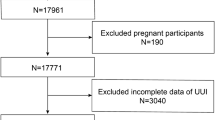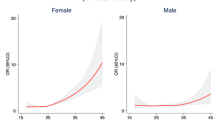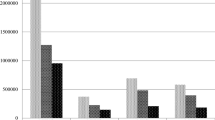Abstract
Background:
Epidemiological studies have reported conflicting results relating obesity to BPH. A meta-analysis of cohort and case–control studies was conducted to pool the risk estimates of the association between obesity and BPH.
Methods:
Eligible studies were retrieved by both computer searches and review of references. We analyzed abstracted data with random effects models to obtain the summary risk estimates. Dose–response meta-analysis was performed for studies reporting categorical risk estimates for a series of exposure levels.
Results:
A total of 19 studies met the inclusion criteria of the meta-analysis. Positive association with body mass index (BMI) was observed in BPH and lower urinary tract symptoms (LUTS) combined group (odds ratio=1.27, 95% confidence intervals 1.05–1.53). In subgroup analysis, BMI exhibited a positive dose–response relationship with BPH/LUTS in population-based case–control studies and a marginal positive association was observed between risk of BPH and increased BMI. However, no association between BPH/LUTS and BMI was observed in other subgroups stratified by study design, geographical region or primary outcome.
Conclusions:
The overall current literatures suggested that BMI was associated with increased risk of BPH. Further efforts should be made to confirm these findings and clarify the underlying biological mechanisms.
This is a preview of subscription content, access via your institution
Access options
Subscribe to this journal
Receive 4 print issues and online access
$259.00 per year
only $64.75 per issue
Buy this article
- Purchase on Springer Link
- Instant access to full article PDF
Prices may be subject to local taxes which are calculated during checkout


Similar content being viewed by others
References
Berry SJ, Coffey DS, Walsh PC, Ewing LL . The development of human benign prostatic hyperplasia with age. J Urol 1984; 132: 474–479.
Wei JT, Calhoun E, Jacobsen SJ . Urologic diseases in America project: benign prostatic hyperplasia. J Urol 2005; 173: 1256–1261.
Parsons JK . Modifiable risk factors for benign prostatic hyperplasia and lower urinary tract symptoms: new approaches to old problems. J Urol 2007; 178: 395–401.
Parsons JK, Sarma AV, McVary K, Wei JT . Obesity and benign prostatic hyperplasia: clinical connections, emerging etiological paradigms and future directions. J Urol 2009; 182 (6 Suppl): S27–S31.
Nandeesha H . Benign prostatic hyperplasia: dietary and metabolic risk factors. Int Urol Nephrol 2008; 40: 649–656.
DerSimonian R, Laird N . Meta-analysis in clinical trials. Control Clin Trials 1986; 7: 177–188.
Greenland S, Longnecker MP . Methods for trend estimation from summarized dose-response data, with applications to meta-analysis. Am J Epidemiol 1992; 135: 1301–1309.
Lau J, Ioannidis JP, Schmid CH . Quantitative synthesis in systematic reviews. Ann Intern Med 1997; 127: 820–826.
Zintzaras E, Ioannidis JP . Heterogeneity testing in meta-analysis of genome searches. Genet Epidemiol 2005; 28: 123–137.
Egger M, Davey Smith G, Schneider M, Minder C . Bias in meta-analysis detected by a simple, graphical test. BMJ 1997; 315: 629–634.
Begg CB, Mazumdar M . Operating characteristics of a rank correlation test for publication bias. Biometrics 1994; 50: 1088–1101.
Lee SH, Kim JC, Lee JY, Kim JH, Oh CY, Lee SW et al. Effects of components of metabolic syndrome on sexual function in Korean BPH/LUTS patients. J Sex Med 2009; 6: 2292–2298.
Lee SH, Kim JC, Lee JY, Kim JH, Oh CY, Lee SW et al. Effects of obesity on lower urinary tract symptoms in Korean BPH patients. Asian J Androl 2009; 11: 663–668.
Gacci M, Bartoletti R, Figlioli S, Sarti E, Eisner B, Boddi V et al. Urinary symptoms, quality of life and sexual function in patients with benign prostatic hypertrophy before and after prostatectomy: a prospective study. BJU Int 2003; 91: 196–200.
Overland GB, Vatten L, Rhodes T, DeMuro C, Jacobsen G, Vada K et al. Lower urinary tract symptoms, prostate volume and uroflow in Norwegian community men. Eur Urol 2001; 39: 36–41.
Lee E, Park MS, Shin C, Lee H, Yoo K, Kim Y et al. A high-risk group for prostatism: a population-based epidemiological study in Korea. Br J Urol 1997; 79: 736–741.
Liao CH, Li HY, Chung SD, Chiang HS, Yu HJ . Significant association between serum dihydrotestosterone level and prostate volume among Taiwanese men aged 40–79 years. Aging Male 2011; e-pub ahead of print 19 January 2011.
Prezioso D, Catuogno C, Galassi P, D’Andrea G, Castello G, Pirritano D . Life-style in patients with LUTS suggestive of BPH. Eur Urol 2001; 40 (Suppl 1): 9–12.
Hong J, Kwon S, Yoon H, Lee H, Lee B, Kim HH et al. Risk factors for benign prostatic hyperplasia in South Korean men. Urol Int 2006; 76: 11–19.
Joseph MA, Wei JT, Harlow SD, Cooney KA, Dunn RL, Jaffe CA et al. Relationship of serum sex-steroid hormones and prostate volume in African American men. Prostate 2002; 53: 322–329.
Haidinger G, Temml C, Schatzl G, Brossner C, Roehlich M, Schmidbauer CP et al. Risk factors for lower urinary tract symptoms in elderly men. For the Prostate Study Group of the Austrian Society of Urology. Eur Urol 2000; 37: 413–420.
Sarma AV, Jaffe CA, Schottenfeld D, Dunn R, Montie JE, Cooney KA et al. Insulin-like growth factor-1, insulin-like growth factor binding protein-3, and body mass index: clinical correlates of prostate volume among Black men. Urology 2002; 59: 362–367.
Glynn RJ, Campion EW, Bouchard GR, Silbert JE . The development of benign prostatic hyperplasia among volunteers in the Normative Aging Study. Am J Epidemiol 1985; 121: 78–90.
Joseph MA, Harlow SD, Wei JT, Sarma AV, Dunn RL, Taylor JM et al. Risk factors for lower urinary tract symptoms in a population-based sample of African-American men. Am J Epidemiol 2003; 157: 906–914.
Morrison AS . Risk factors for surgery for prostatic hypertrophy. Am J Epidemiol 1992; 135: 974–980.
Hammarsten J, Hogstedt B . Clinical, anthropometric, metabolic and insulin profile of men with fast annual growth rates of benign prostatic hyperplasia. Blood Press 1999; 8: 29–36.
Meigs JB, Mohr B, Barry MJ, Collins MM, McKinlay JB . Risk factors for clinical benign prostatic hyperplasia in a community-based population of healthy aging men. J Clin Epidemiol 2001; 54: 935–944.
Burke JP, Rhodes T, Jacobson DJ, McGree ME, Roberts RO, Girman CJ et al. Association of anthropometric measures with the presence and progression of benign prostatic hyperplasia. Am J Epidemiol 2006; 164: 41–46.
Safarinejad MR . Prevalence of benign prostatic hyperplasia in a population-based study in Iranian men 40 years old or older. Int Urol Nephrol 2008; 40: 921–931.
Giovannucci E, Rimm EB, Chute CG, Kawachi I, Colditz GA, Stampfer MJ et al. Obesity and benign prostatic hyperplasia. Am J Epidemiol 1994; 140: 989–1002.
Signorello LB, Tzonou A, Lagiou P, Samoli E, Zavitsanos X, Trichopoulos D . The epidemiology of benign prostatic hyperplasia: a study in Greece. BJU Int 1999; 84: 286–291.
Parsons JK, Carter HB, Partin AW, Windham BG, Metter EJ, Ferrucci L et al. Metabolic factors associated with benign prostatic hyperplasia. J Clin Endocrinol Metab 2006; 91: 2562–2568.
Fritschi L, Tabrizi J, Leavy J, Ambrosini G, Timperio A . Risk factors for surgically treated benign prostatic hyperplasia in Western Australia. Public Health 2007; 121: 781–789.
Gann PH, Hennekens CH, Longcope C, Verhoek-Oftedahl W, Grodstein F, Stampfer MJ . A prospective study of plasma hormone levels, nonhormonal factors, and development of benign prostatic hyperplasia. Prostate 1995; 26: 40–49.
Porta M, Fernandez E, Alonzo J, Anto JM . Re: risk factors for benign prostatic hypertrophy. Am J Epidemiol 1994; 139: 114–115.
Kristal AR, Arnold KB, Schenk JM, Neuhouser ML, Weiss N, Goodman P et al. Race/ethnicity, obesity, health related behaviors and the risk of symptomatic benign prostatic hyperplasia: results from the prostate cancer prevention trial. J Urol 2007; 177: 1395–1400; quiz 1591.
Xie LP, Bai Y, Zhang XZ, Zheng XY, Yao KS, Xu L et al. Obesity and benign prostatic enlargement: a large observational study in China. Urology 2007; 69: 680–684.
Zucchetto A, Tavani A, Dal Maso L, Gallus S, Negri E, Talamini R et al. History of weight and obesity through life and risk of benign prostatic hyperplasia. Int J Obes (Lond) 2005; 29: 798–803.
Seitter WR, Barrett-Connor E . Cigarette smoking, obesity, and benign prostatic hypertrophy: a prospective population-based study. Am J Epidemiol 1992; 135: 500–503.
Dahle SE, Chokkalingam AP, Gao YT, Deng J, Stanczyk FZ, Hsing AW . Body size and serum levels of insulin and leptin in relation to the risk of benign prostatic hyperplasia. J Urol 2002; 168: 599–604.
Rohrmann S, Smit E, Giovannucci E, Platz EA . Associations of obesity with lower urinary tract symptoms and noncancer prostate surgery in the Third National Health and Nutrition Examination Survey. Am J Epidemiol 2004; 159: 390–397.
Wong SY, Woo J, Hong A, Leung JC, Kwok T, Leung PC . Risk factors for lower urinary tract symptoms in southern Chinese men. Urology 2006; 68: 1009–1014.
Rohrmann S, Fallin MD, Page WF, Reed T, Partin AW, Walsh PC et al. Concordance rates and modifiable risk factors for lower urinary tract symptoms in twins. Epidemiology 2006; 17: 419–427.
Seim A, Hoyo C, Ostbye T, Vatten L . The prevalence and correlates of urinary tract symptoms in Norwegian men: the HUNT study. BJU Int 2005; 96: 88–92.
Lee S, Min HG, Choi SH, Kim YJ, Oh SW, Park Y et al. Central obesity as a risk factor for prostatic hyperplasia. Obesity (Silver Spring) 2006; 14: 172–179.
Behavioral risk factor surveillance system (database on the Internet) www.cdc.gov/brfss; 2009.
National Cholesterol Education Program (NCEP) Expert Panel on Detection, Evaluation, and Treatment of High Blood Cholesterol in Adults (Adult Treatment Panel III). Third Report of the National Cholesterol Education Program (NCEP) Expert Panel on Detection, Evaluation, and Treatment of High Blood Cholesterol in Adults (Adult Treatment Panel III) final report. Circulation 2002; 106: 3143–3421.
Rahman NU, Phonsombat S, Bochinski D, Carrion RE, Nunes L, Lue TF . An animal model to study lower urinary tract symptoms and erectile dysfunction: the hyperlipidaemic rat. BJU Int 2007; 100: 658–663.
Furukawa S, Fujita T, Shimabukuro M, Iwaki M, Yamada Y, Nakajima Y et al. Increased oxidative stress in obesity and its impact on metabolic syndrome. J Clin Invest 2004; 114: 1752–1761.
Nickel JC, Downey J, Young I, Boag S . Asymptomatic inflammation and/or infection in benign prostatic hyperplasia. BJU Int 1999; 84: 976–981.
Di Silverio F, Gentile V, De Matteis A, Mariotti G, Giuseppe V, Luigi PA et al. Distribution of inflammation, pre-malignant lesions, incidental carcinoma in histologically confirmed benign prostatic hyperplasia: a retrospective analysis. Eur Urol 2003; 43: 164–175.
Nomura AM . Body size and prostate cancer. Epidemiol Rev 2001; 23: 126–131.
Chan JM, Stampfer MJ, Giovannucci EL . What causes prostate cancer? A brief summary of the epidemiology. Semin Cancer Biol 1998; 8: 263–273.
Acknowledgements
This study was supported by grants from the National Natural Science Foundation of China (Grant No. 30801370).
Author information
Authors and Affiliations
Corresponding author
Ethics declarations
Competing interests
The authors declare no conflict of interest.
Rights and permissions
About this article
Cite this article
Wang, S., Mao, Q., Lin, Y. et al. Body mass index and risk of BPH: a meta-analysis. Prostate Cancer Prostatic Dis 15, 265–272 (2012). https://doi.org/10.1038/pcan.2011.65
Received:
Revised:
Accepted:
Published:
Issue Date:
DOI: https://doi.org/10.1038/pcan.2011.65
Keywords
This article is cited by
-
Omentin-1 inhibits the development of benign prostatic hyperplasia by attenuating local inflammation
Molecular Medicine (2024)
-
The role of the serum 25-OH vitamin D level on detecting prostate cancer in men with elevated prostate-specific antigen levels
Scientific Reports (2022)
-
Correlation between body mass index and prostate volume in benign prostatic hyperplasia patients undergoing holmium enucleation of the prostate surgery
BMC Urology (2021)
-
Body size throughout the life-course and incident benign prostatic hyperplasia-related outcomes and nocturia
BMC Urology (2021)
-
The correlation between obesity and prostate volume in patients with benign prostatic hyperplasia at Charlotte Maxeke Johannesburg Academic Hospital
African Journal of Urology (2021)



